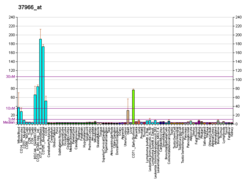| PARVB | |||||||||||||||||||||||||||||||||||||||||||||||||||
|---|---|---|---|---|---|---|---|---|---|---|---|---|---|---|---|---|---|---|---|---|---|---|---|---|---|---|---|---|---|---|---|---|---|---|---|---|---|---|---|---|---|---|---|---|---|---|---|---|---|---|---|
| |||||||||||||||||||||||||||||||||||||||||||||||||||
| Identifiers | |||||||||||||||||||||||||||||||||||||||||||||||||||
| Aliases | PARVB, CGI-56, parvin beta | ||||||||||||||||||||||||||||||||||||||||||||||||||
| External IDs | OMIM: 608121; MGI: 2153063; HomoloGene: 8342; GeneCards: PARVB; OMA:PARVB - orthologs | ||||||||||||||||||||||||||||||||||||||||||||||||||
| |||||||||||||||||||||||||||||||||||||||||||||||||||
| |||||||||||||||||||||||||||||||||||||||||||||||||||
| |||||||||||||||||||||||||||||||||||||||||||||||||||
| |||||||||||||||||||||||||||||||||||||||||||||||||||
| |||||||||||||||||||||||||||||||||||||||||||||||||||
| Wikidata | |||||||||||||||||||||||||||||||||||||||||||||||||||
| |||||||||||||||||||||||||||||||||||||||||||||||||||
Beta-parvin is a protein that in humans is encoded by the PARVB gene.
Members of the parvin family, including PARVB, PARVA and PARVG, are actin-binding proteins associated with focal contacts.
References
- ^ GRCh38: Ensembl release 89: ENSG00000188677 – Ensembl, May 2017
- ^ GRCm38: Ensembl release 89: ENSMUSG00000022438 – Ensembl, May 2017
- "Human PubMed Reference:". National Center for Biotechnology Information, U.S. National Library of Medicine.
- "Mouse PubMed Reference:". National Center for Biotechnology Information, U.S. National Library of Medicine.
- Lai CH, Chou CY, Ch'ang LY, Liu CS, Lin W (Aug 2000). "Identification of novel human genes evolutionarily conserved in Caenorhabditis elegans by comparative proteomics". Genome Res. 10 (5): 703–13. doi:10.1101/gr.10.5.703. PMC 310876. PMID 10810093.
- Olski TM, Noegel AA, Korenbaum E (Feb 2001). "Parvin, a 42 kDa focal adhesion protein, related to the alpha-actinin superfamily". J Cell Sci. 114 (Pt 3): 525–38. doi:10.1242/jcs.114.3.525. PMID 11171322.
- ^ "Entrez Gene: PARVB parvin, beta".
Further reading
- Dunham I, Shimizu N, Roe BA, et al. (1999). "The DNA sequence of human chromosome 22". Nature. 402 (6761): 489–95. Bibcode:1999Natur.402..489D. doi:10.1038/990031. PMID 10591208.
- Yamaji S, Suzuki A, Sugiyama Y, et al. (2001). "A novel integrin-linked kinase-binding protein, affixin, is involved in the early stage of cell-substrate interaction". J. Cell Biol. 153 (6): 1251–64. doi:10.1083/jcb.153.6.1251. PMC 2192033. PMID 11402068.
- Korenbaum E, Olski TM, Noegel AA (2002). "Genomic organization and expression profile of the parvin family of focal adhesion proteins in mice and humans". Gene. 279 (1): 69–79. doi:10.1016/S0378-1119(01)00743-0. PMID 11722847.
- Yamaji S, Suzuki A, Kanamori H, et al. (2002). "Possible role of ILK-affixin complex in integrin-cytoskeleton linkage during platelet aggregation". Biochem. Biophys. Res. Commun. 297 (5): 1324–31. doi:10.1016/S0006-291X(02)02381-1. PMID 12372433.
- Strausberg RL, Feingold EA, Grouse LH, et al. (2003). "Generation and initial analysis of more than 15,000 full-length human and mouse cDNA sequences". Proc. Natl. Acad. Sci. U.S.A. 99 (26): 16899–903. Bibcode:2002PNAS...9916899M. doi:10.1073/pnas.242603899. PMC 139241. PMID 12477932.
- Rosenberger G, Jantke I, Gal A, Kutsche K (2003). "Interaction of alphaPIX (ARHGEF6) with beta-parvin (PARVB) suggests an involvement of alphaPIX in integrin-mediated signaling". Hum. Mol. Genet. 12 (2): 155–67. doi:10.1093/hmg/ddg019. PMID 12499396.
- Collins JE, Goward ME, Cole CG, et al. (2003). "Reevaluating human gene annotation: a second-generation analysis of chromosome 22". Genome Res. 13 (1): 27–36. doi:10.1101/gr.695703. PMC 430954. PMID 12529303.
- Mishima W, Suzuki A, Yamaji S, et al. (2004). "The first CH domain of affixin activates Cdc42 and Rac1 through alphaPIX, a Cdc42/Rac1-specific guanine nucleotide exchanging factor". Genes Cells. 9 (3): 193–204. doi:10.1111/j.1356-9597.2004.00717.x. PMID 15005707.
- Yamaji S, Suzuki A, Kanamori H, et al. (2004). "Affixin interacts with alpha-actinin and mediates integrin signaling for reorganization of F-actin induced by initial cell-substrate interaction". J. Cell Biol. 165 (4): 539–51. doi:10.1083/jcb.200308141. PMC 2172344. PMID 15159419.
- Zhang Y, Chen K, Tu Y, Wu C (2004). "Distinct roles of two structurally closely related focal adhesion proteins, alpha-parvins and beta-parvins, in regulation of cell morphology and survival". J. Biol. Chem. 279 (40): 41695–705. doi:10.1074/jbc.M401563200. PMID 15284246.
- Mongroo PS, Johnstone CN, Naruszewicz I, et al. (2004). "Beta-parvin inhibits integrin-linked kinase signaling and is downregulated in breast cancer". Oncogene. 23 (55): 8959–70. doi:10.1038/sj.onc.1208112. PMID 15467740.
- Gerhard DS, Wagner L, Feingold EA, et al. (2004). "The status, quality, and expansion of the NIH full-length cDNA project: the Mammalian Gene Collection (MGC)". Genome Res. 14 (10B): 2121–7. doi:10.1101/gr.2596504. PMC 528928. PMID 15489334.
- Matsuda C, Kameyama K, Tagawa K, et al. (2005). "Dysferlin interacts with affixin (beta-parvin) at the sarcolemma". J. Neuropathol. Exp. Neurol. 64 (4): 334–40. doi:10.1093/jnen/64.4.334. PMID 15835269.
- Ewing RM, Chu P, Elisma F, et al. (2007). "Large-scale mapping of human protein-protein interactions by mass spectrometry". Mol. Syst. Biol. 3 (1): 89. doi:10.1038/msb4100134. PMC 1847948. PMID 17353931.
This article on a gene on human chromosome 22 is a stub. You can help Misplaced Pages by expanding it. |






